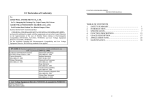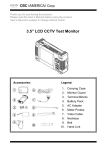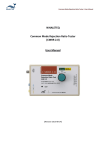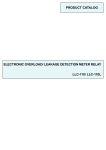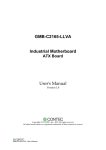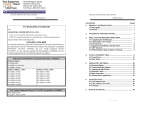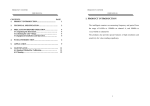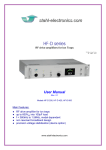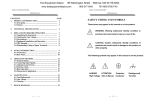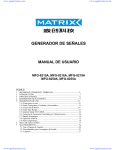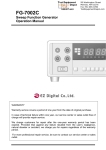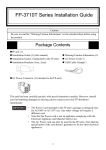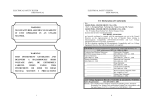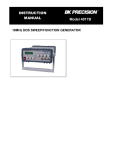Download EC Declaration of Conformity GFG-8210
Transcript
FUNCTION GENERATOR USER MANUAL EC Declaration of Conformity We GOOD WILL INSTRUMENT CO., LTD. (1) No. 95-11, Pao-Chung Rd., Hsin-Tien City, Taipei Hsien, Taiwan (2) Plot 522, Lorong Perusahaan Baru 3, Prai Industrial Estate, 13600 Prai, Penang, Malaysia declares that the below mentioned product GFG-8210 is herewith confirmed to comply with the requirements set out in the Council Directive on the Approximation of the Law of Member States relating to Electromagnetic Compatibility (89/366/EEC, 92/31/EEC, 93/68/EEC) and Low Voltage Equipment Directive (73/23/EEC). For the evaluation regarding the Electromagnetic Compatibility and Low Voltage Equipment Directive, the following standards were applied: EMC Directive 89/366/EEC amended by 92/31/EEC; 93/68/EEC EN 50081-2 (1992): Electromagnetic Compatibility- Generic Emission Standard. Part 2: Industrial environment. Conducted and Radiated Emissions EN 55011:1998 Group 1 Class A Current Harmonic EN 61000-3-2 (1995) Voltage Fluctuation EN 61000-3-3 (1995) EN 50082-2 (1992): Electromagnetic Compatibility- Generic Immunity Standard. Part 2: Industrial environment. Electrostatic Discharge EN 61000-4-2: 1995 Radiated Immunity EN 61000-4-3: 1996 Electrical Fast Transients EN 61000-4-4: 1995 Surge Immunity EN 61000-4-5: 1995 Voltage Dips/ Interrupts EN 61000-4-11: 1994 Low Voltage Equipment Directive 73/23/EEC & amended by 93/68/EEC Safety Requirements IEC 61010-1:1990+A1:1992+A2:1995; EN 61010-1: 1993+A2:1995; 2 FUNCTION GENERATOR FUNCTION GENERATOR USER MANUAL TABLE OF CONTENTS USER MANUAL PAGE 1.SAFETY TERMS AND SYMBOLS 1. SAFETY SUMMARY… … … … … … … … … … … … … … … … … .. 1 2. INTRODUCTION… … … … … … … … … … … … … … … … … … … 5 3. SPECIFICATION… … … … … … … … … … … … … … … … … … … 6 4. FUNCTION DESCRIPTION.… … … … … … … … … … … … … … . 11 5. USAGE DESCRIPTION… … … … … … … … … … … … … … … … . 14 6. APPLICATION NOTE… … … … … … … … … … … … … … … … … 20 WARNING. Warning statements identify condition or 7. MAINTENANCE… … … … … … … … … … … … … … … … … … … . 30 practices that could result in injury or loss of life. Please take a moment to review these safety terms and symbols which may appear in this manual or on Equipment to prevent damage to the Function Generators. CAUTION. Caution statements identify conditions or practices that could result in damage to this product or other property. 3 1 FUNCTION GENERATOR FUNCTION GENERATOR USER MANUAL USER MANUAL FOR UNITED KINGDOM ONLY DANGER High Voltage NOTE: This lead/appliance must only be wired by competent persons ATTENTION refer to Manual WARNING: THIS APPLIANCE MUST BE EARTHED IMPORTANT: The wires in this lead are coloured in accordance with the following code: Protective Conductor Terminal Green/ Yellow: Earth Blue: Neutral Brown: Live(Phase) (ground) Earth Terminal Frame or Chassis Terminal As the colours of the wires in main leads may not correspond with the colours marking identified in your plug/appliance, proceed as follows: The wire which is coloured Green & Yellow must be connected to the Earth terminal marked with the letter E or by the earth symbol or coloured Green or Green & Yellow. 2 3 FUNCTION GENERATOR FUNCTION GENERATOR USER MANUAL The wire which is coloured Blue must be connected to the terminal which is marked with the letter N or coloured Blue or Black. USER MANUAL 2. INTRODUCTION The GFG -8210 Function Generator is a stable low distortion instrument which generate signals in the frequency range up to 10MHz. Typical applications include a wide range of audio response testing The wire which is coloured Brown must be connected to the terminal marked with the letter L or P or coloured Brown or Red. applications, vibration testing, servo system evaluation, ultra sound applications, and etc. If in doubt, consult the instructions provided with the equipment or contact the supplier. This cable/appliance should be protected by a suitably rated and approved HBC mains fuse : refer to the rating information on the equipment and/or user instructions for details. As a guide, cable of 0.75mm² should be protected by a 3A or 5A fuse. Larger conductors would normally require 13A types, depending on the connection method used. The instrument includes the following features: logarithmic and linear Any moulded mains connector that requires removal /replacement must be destroyed by removal of any fuse & fuse carrier and disposed of immediately, as a plug with bared wires is hazardous if a engaged in live socket. Any re-wiring must be carried out in accordance with the information detailed on this label. sweep capabilities, together with a built in frequency counter. The sweep capability simplifies the task of finding resonant points of speakers, filter networks and other networks/structures. An oscilloscope may be connected to this instrument for the respons e to be displayed. The counter can be switched to measure and display the frequency of an external signal up to 150MHz. l ADDITIONAL FEATURES 1. Low distortion waveforms (sine, triangular and square). 2. Signal output in eight decade stages, 0.1Hz to 10MHz. 3. Adjustable sweep time and sweep width both in linear and logarithmic modes. 4. Duty cycle control with signal inversion capability. 5. External Voltage controlled Frequency (VCF). 6. A second output for TTL or adjustable CMOS pulses. 7.50 ohm main signal output with DC offset adjustment and 20dB attenuation capability. 8. Supplied with two BNC test leads and AC power cord set. 4 5 FUNCTION GENERATOR FUNCTION GENERATOR USER MANUAL USER MANUAL 3. SPECIFICATION GFC-8210 GFG-8210 1.Main Frequency Range Amplitude Impedance Attenuator DC Offset Duty Control Display 0.1Hz∼ 10MHz (8 Range) ≧10Vpp (into 50Ωload) 50Ω ± 10% -20dB±1dB× 2 <-5V∼>5V (into 50Ω load) 15%:85%:15% to 1MHz Continued variable(square wave only) 6 digits LED display 2.Sine Wave 8.Sweep Operation Sweep/Manual Switch selector Sweep/Rate Sweep/Time Sweep/Mode >100:1 ratio max. and adjustable 0.5Sec∼30Sec adjustable Lin./Log. switch selector Sweep Out 0V~10±1V 9. Frequency Counter Int./Ext. Switch selector Range 0.1Hz∼ 10MHz (5Hz~150MHz EXT) Distortion 1% typical , <3% max at 1kHz. Accuracy ±0.45dB ( ±5%) Time base accuracy ±1 count Flatness Time Base ±20ppm (23℃± 5℃) after 30 minutes warm up The maximum resolution is 100nHz for 1Hz and 1Hz for 100MHz. 3.Triangle Wave Linear Resolution ≧98% to 100kHz 4.Square Wave Symmetry Rise time Input Impedance ±2%, 1Hz∼100kHz ≦35ns 5.CMOS Output Max. Frequency Level Rise or Fall Time 2MHz ≦4Vpp∼14.5Vpp±0.5Vpp adjustable ≦120ns 6.TTL Output Level Rise or Fall Time ≧3Vpp ≦20ns 7.VCF Input voltage Input Impedance 0V∼ 10V (100:1) 10kΩ± 10% 6 Sensitivity 1MΩ/150nF ≦35mVrms(5Hz~100MHz) ≦45mVrms(100MHz~150MHz) 10.General Power Source AC115V, 230V± 15% 50/60Hz Indoor use, altitude up to 2000m. Ambient Temperature 0℃ to 40℃. Operation Relative Humidity 80% (Maximum). Environment Installation category II Pollution Degree 2 Storage temperature -10℃ to 70℃. & Humidity 70% (Maximum). GTL-101 × 2 Accessories Instruction manual × 1 Dimension 251(W)×91(H)×291(D) m/m Approx. 2.2 kg Weigh 7 FUNCTION GENERATOR FUNCTION GENERATOR USER MANUAL USER MANUAL l Fig 4.1 FRONT PANEL WARNING? To avoid electrical shock, the power cord 6 4 2 12a 7 protective grounding conductor must be connected to ground. GATE 0.01 0.1 1 10 1M CAUTION? To avoid damaging the instrument, do not use OVER M k FREQUENCY m Hz 10k 10M 1k 100 10 1 ATT -20dB GATE SWEEP DUTY it in a place where ambient temperature exceeds 40℃. 100k CMOS OFFSET AMPL OUTPUT OUTPUT TTL/CMOS 50 POWER 0 SLOW COARSE MAX FAST TIME FINE PULL SWEEP ON 5V ADJ 15V - CMOS ADJ TTL RATE PULL LOG + MIN ADJ MAX -20dB R GFG-8210 FUNCTION GENERATOR CAUTION? To avoid damaging the instrument, do not input more than DC15V to V.C.F.(V.C.G.). 3 1 13 5 14 9 10 11 CAUTION? To avoid damaging the instrument, do not input more than AC150V to Frequency Counters 8 9 2a 12 17 8 19 FUNCTION GENERATOR FUNCTION GENERATOR USER MANUAL USER MANUAL 4. FUNCTION DESCRIPTION Fig.4-2 REAR PANEL 15 20 115 l COUNTER INT 1. Power Switch Connect the AC power, then press power switch. 2. Gate Time Indicator Press the power switch, Gate time indicator will start to flash (the gate time of internal counter is 0.01 second). 2a. Gate Time Selector Press this key to change gate time when use external counter mode. The change order is according to 0.01s, 0.1s, 1s,10s cycle by pressing these keys. 3. Over Indicator In the external counter mode, the indicator is illuminated when the output frequency is greater than the range selected. 4. Counter Display Shows the external frequency by 6×0.3" green display, and shows the internal frequency by 5×0.3" green display. 5. Frequency Indicator Indicate the current frequency value. 6. Gate Time Indicator Indicate the current Gate time (external. counter mode use only). 7. Frequency Range To select the required frequency range by pressing the Selector relevant push button on the panel as shown in Table 1. 28VA 22W EXT AC VCF INPUT SWEEP OUTPUT COUNTER INPUT DC 15V MAX 18 WARNING AC 30Vrms MAX CAT TO AVOID SHOCK, REMOVE INPUTS BEFORE OPENING. FUSE RATING 115V T0.25A 250V 230V T0.125A 250V 16 Table 1 Push bottom Frequency Range 10 1 10 100 1k 10k 100k 1M 1.3Hz 1Hz 10Hz 100Hz 1kHz 10kHz 100kHz ∣ ∣ ∣ ∣ ∣ ∣ ∣ 1Hz 10Hz 100Hz 1kHz 10kHz 100kHz 1MHz 11 10M 1M ∣ 10M FUNCTION GENERATOR FUNCTION GENERATOR USER MANUAL 8. Function Selector 9. Duty Function 10. TTL/CMOS Selector When push in the knob, the BNC terminal of will output a TTL compatible waveform. If pull out and rotate the knob can adjust the CMOS compatible output (5-15Vpp) from the output of BNC . 11. 12. DC Offset Control Output Amplitude Control with Attenuation Operation 12a. 20dB Attenuation 13 Press one of the three push buttons to select the desired output waveform. Pull out and rotate the knob to adjust the duty cycle of the waveform (Square wave only). Pull out the knob to select any DC level of the waveform between ±10V, turn clockwise to set a positive DC level waveform and invert for a negative DC level waveform. Turn clockwise for MAX. output and invert for a –20dB output. Pull the knob out for an additional 20dB output attenuation. USER MANUAL 14 Sweep Time Control and LIN/LOG Selector (3) To proceed Linear sweep mode by pushing in the knob, or select LOG sweep mode by pulling out the knob. 15. INT/EXT Counter Select internal counter mode (count the frequency of Selector model) or select EXT counter mode for an independent counter (input signal from BNC 16 ). 16. EXT. Counter Input Terminal Accepts external signals for measurement. 17. TTL/CMOS Output Terminal TTL/CMOS compatible signal output 18. VCF IN/Sweep Out Terminal (1).Use to connect the input voltage required to perform the “voltage control frequency” operation or the EXT modulation operation. (2).In Sweep mode, this terminal will output sweep signal. 19. Main Output Terminal Main signal output. 20. Power Switch 115V and 230V selectable. Press the knob to adjust a –20dB output. SWEEP ON Selector Pres s and turn clockwise the knob for MAX frequency and Frequency and invert for MIN frequency. (outer knob is for coarse Adjustment adjustment, and internal knob is for fine adjustment.) (Sweep On/Off) Pull out the knob to start the auto sweep operation; the upper frequency limit is determined by the knob position. 12 (1) Rotate the outer knob clockwise to adjust sweep time for MAX, or invert for MIN. (2) Rotate the outer knob clockwise to adjust sweep width can control 0 to 100 times. 13 FUNCTION GENERATOR FUNCTION GENERATOR USER MANUAL USER MANUAL 5. USAGE DESCRIPTION (3) Rotate AMPL 12 again to control waveform amplitude. (4) If attenuation output signal is required, pull out AMPL These function generator can provide versatile waveforms of high efficiency and convenient operation. Familiarize yourselves with the function thoroughly through Operation Manual and practice with all accurate operation procedures can lead you to easily master the performance of the Function Generator. obtain 20dB attenuation or press l Figure 1. instrument to Oscilloscope. Watch the effect in different control of waveforms through Oscilloscope carefully when proceeding the following steps: 5-1.First-step check: (1) Ensure that the voltage of the main supply is compatible with this instrument. The label on the rear panel states the required AC voltage. (2) Connect the instrument to the main supply using the power cord supplied. (3) Press PWR switch 1 and ensure all the rotary controls are pushed in, then rotate AMPL 12 knob to make the indication point up forward. (4) Rotate the FREQ 13 control fully anticlockwise. 5-2.Triangle, square and sine wave (1) First select Function 8 , and select Range 7 , rotate FREQ to set the required frequency.(read out from display window). 13 , (2) At this moment, connect Output , to oscilloscope for observing output signal, or connect to other experiment circuit. 14 knob to knob for additional 20dB attenuation.. (5) The phase-relation of Output Waveform shown in Figure 1 as below: It is one of the best ways to observe waveforms by connecting the 12 15 FUNCTION GENERATOR FUNCTION GENERATOR USER MANUAL USER MANUAL 10 5-3.Pulse wave generation (1) First pres s the key ( ) of Function 8 7 , and rotate FREQ 13 , to set required frequency range. (2) Connect output-terminal to oscilloscope for observing output signal. (3) Pull out and rotate Duty ‰ to adjust the width of pulse waveform. (4) Adjust AMPL 1 2 knob to control pulse amplitude. (5) Pull out AMPL 12 knob to get 20dB attenuation of output. 5-4.Ramp wave generation (1) First press the key ( ) of Function 8 knob to adjust voltage level. ; then select Range , then select Range 7 5-6.Variation of external voltage -controlled frequency This mode of operation allows the user to adjust the frequency of the function generator with an external DC control Voltage. It also provides an easy way for your adjustment. (1) Select Function 8 first, then select Range to set required frequency range. 7 , rotate FREQ 13 (2) Connect external control voltage (0 ±10V) to the VCF , rotate FEEQ 1 3 switch to set required frequency range. (2).Connect output-terminal to oscilloscope for observing output signal. connector via a suitable lead, and generate signal from Output . 12 (3) Other adjustments, such as AMPL switch can change amplitude of signal, or get attenuation; adjust Offset 11 for DC (3) Pull out and rotate DUTY‰ to adjust the slope of ramp waveform. level, rotate Duty ‰ switch can change output signal of pulse or (4).Adjust AMPL waveform. 12 (5).Pull out AMPL 12 knob to control output amplitude of ramp ramp waveform etc.. 5-7.Auto Sweep knob to obtain 20dB attenuation of output. 5-5.TTL/CMOS signal output (1) First select Range range. 7 , rotate FREQ 13 to set required frequency (1) First select the required waveform by pressing Function then select required frequency range by pressing range button. (2) Connect output terminal signal. (2) Connect BNC connector of TTL/CMOS to oscilloscope or to other experiment circuit for observing output signal. (3) At this moment, output is square waveform fixing to TTL level; suits for general TTL integrated circuit. (3) Rotate frequency 13 button, 8 7 push to oscilloscope for observing output to determine the upper limit frequency. (4) Pull out frequency 13 to perform auto-sweep operation. (5) Rotate SWEEP/TIME 14 and SWEEP/RATE 14 to adjust sweep time and rate. (6) Pull out (press) LIN/LOG 14 to obtain LOG (LIN) sweep mode. (4) If square waveform of CMOS level is required, can pull out CMOS Note: The sweep width can only be adjusted during the sweep cycle 16 17 FUNCTION GENERATOR FUNCTION GENERATOR USER MANUAL USER MANUAL and it can not be stopped. l Figure 2. 5-8. Precaution item (1) Adjust DC OFFSET, will provide to change voltage of ± 10V (no load) or ±5V (50Ω load). However, signal added DC level, is still limited to ±20V (no load) or ±10V (50Ω load). In case of over-voltage, clip will appear as shown in Figure 2: (2) Output connector label 50 Ω , indicated that signal source impedance is 50Ω. Connect to any of impedance circuit, but output voltage and terminal impedance will be rated. To avoid oscillation, terminal shall be connected to 50Ω (When using high frequency and square output), and its connecting line shall be as short as possible. (3) When adjust Duty knob to leftward position, the ratio of positive state to negative state, expand to not less than 80:20. It can expand Square wave to Pulse wave, expand Triangle wave to Ramp wave l Figure 3. and Sine wave to unsymmetrical Sine wave. As shown in Figure 3 is for adjustment of Duty control to obtain required waveform. 18 19 FUNCTION GENERATOR FUNCTION GENERATOR USER MANUAL USER MANUAL 6. APPLICATION NOTE (D) Using the Square wave test the characteristics of amplifier circuit. This section describes the application of the Funct ion Generators in details as well as a brief description relating to the block diagram. Only It can’t actually explain the transient response of amplifier by using Sine wave for the frequency response curve observation, but using for the essential application method. the high order poly -wave, Square wave, instead to display its waveform from the oscilloscope can show up many characteristics of (A) Trouble-shooting using signal-tracing method. This method is similar to signal replacing way. The signal of model amplifier. (a) Using the circuit of figure 5, the 50Ω connector trim the will be fixedly sent to input terminal. Observing its signal wave on the oscillation effect of Square wave. oscilloscope from front stage to rear stage orderly until appear a (b) Use the output of Triangle wave, adjust the amplitude until there signal with normal input but with abnormal output. are no clipping happened in the applied frequency. (c) Select Square wave, adjust frequency, choose to watch the (B) Use as bias source and signal source circuit. Utilize the Figure 4 of connecting type, which can provide bias of a transistor and signal input. The output waveform can be observed from oscilloscope. Adjust to the best condition with output max. wave-form of middle of amplifier pass band, like 20Hz, 1kHz, 10kHz and etc. (d) The output waveform of (c), must get something with frequency Figure 6 shows some possible conditions. amplitude and no distortion. Adjust DC OFFSET to see the different effect of different bias condition. CAUTION: The composed poly-wave frequency of (C) Amplifier over-load characteristics The Sine wave input will be different from output the overload point. Square wave is quite large, so it’s not suitable for the narrow band amplifier testing. Using Triangle wave will easily observe the display of oscilloscope. It can decide the linear range of output waveform. And the largest no-distortion output amplitude. (E) Test of logic circuit This equipment is suitable for logic circuit testing. Using Square or Pulse wave can analyze or watch the frequency waveform of a designed testing circuit. Also the DC Offset effect, drive the plug-in model board or logic circuit trouble-shooting and etc. Used 20 21 FUNCTION GENERATOR FUNCTION GENERATOR USER MANUAL as signal tracing and signal replacing operation: USER MANUAL in low frequency. But in approaching the resonant frequency, there are still increasing in voltage, then the impedance can be (a) Connect the lines as Figure 7. (b) According to the operation guide in this manual, set Square wave tested as following: or Pulse wave output. (c) Use the label TTL, CMOS output terminal testing TTL logic (1) Series connect a R1 to the network under test as in Figure 9. (2) Get voltage read out in E1, E2, adjust R1 until E2 is equal to circuit. (d) To test CMOS circuit by pulling up the switch of TTL/CMOS, one half of E1. (3) Under this frequency, the impedance network is the same as and adjust CMOS level by rotating the switch to set the proper the R1. level (e) Use dual-trace scope to show the input -output timing relation judged by the two waves shown in Figure 4. (G)Act as automatic test of speaker Because there provide the auto feature in this equipment, the output can drive to amplifier for testing the frequency response of speaker. (F)Testing of speaking and impedance network (a) Set Auto/Manual to Auto position. This equipment can be used to test the frequency characteristics of speaker or any impedance network. It also can get the resonant (b) (c) Set function to Sine wave Set Range to 20kHz frequency of network. (d) Sweep mode (LIN, LOG), sweep width, sweep time can be (a) Connect the device under test as in Figure 8, can use oscilloscope in stead of voltmeter. (b) When use voltmeter, adjust the frequency of instrument record down voltage relative to frequency. set in any value. (e) The line connected is showed in Figure 11. (c) When testing speaker, if there is a peak volt value, when in low freq., this must be the resonant freq. of this speaker, see Figure 10. Whether installation may cause any effect to this frequency or not? The proper design of case-installation will cause two small ramps on both sides of this sharp ramp. (d) In testing other impedance network, the resonant may not occur 22 23 FUNCTION GENERATOR FUNCTION GENERATOR USER MANUAL l USER MANUAL l FIGURE 4 24 FIGURE 5 25 FUNCTION GENERATOR FUNCTION GENERATOR USER MANUAL USER MANUAL l FIGURE 7 l FIGURE 6 l FIGURE 8 26 27 FUNCTION GENERATOR FUNCTION GENERATOR USER MANUAL l FIGURE 9 USER MANUAL l FIGURE 11 l FIGURE 10 28 29 FUNCTION GENERATOR FUNCTION GENERATOR USER MANUAL USER MANUAL 7. MAINTENANCE 7-2.Fuse Replacement Procedure The following instructions are used by qualified person only. To avoid electrical shock, do not perform any service other than contained in the When you proceed calibration or maintenance of the Function Generators, if you want to replace the fuse, the upper cover must be operation instructions unless you are qualified to do so. removed according to the following steps: 7-1.Fuse Rating and type 1).The handle must be turned downward 90 degrees first. If the fuse blows, the FUNCTION GENERATOR will not operate. Try to determine and correct the cause of the blown fuse, then replace the fuse with the correct rating and type shown below: MODEL GFG8210 FUSE Rating and Type 115V 230V T0.25A 250V T0.125A 250V Rating Input Watts VA 22 28 WARNING: For continued fire protection, replace only with a 250V fuse of the specified type and rating, and disconnect the power cord before proceeding fuse replacement. 30 31 FUNCTION GENERATOR FUNCTION GENERATOR USER MANUAL USER MANUAL 2).Pull apart the handle from the Function Generator. Please turn the 4).Please use a screwdriver to open the screw located at upper side of rear handle left and right side slightly, that will make easier to pull off the handle. panel. Therefore, the upper cover can pull toward the backside. In the meantime, the upper cover is moved. 3).There are two washers inside of two holes (the joints of handle and case) respectively. Please use a screwdriver to pry open these washers. Note: If you want to install the upper cover, please reverse above steps. 7-3. Cleaning To keep the instrument clean, wipe the case with a damp cloth and detergent. Do not use abrasives or solvents. 32 33


















